Aljanah, Epsilon Cygni Aa (ε Cyg Aa) is the primary component in a multiple star system located 72.7 light years away in the constellation Cygnus. With an apparent magnitude of 2.480, the orange giant is the third brightest star in Cygnus, after Deneb and Sadr. Aljanah is one of the five bright stars that form the Northern Cross, a bright asterism that dominates the northern summer sky.
Star system
Epsilon Cygni appears as a single star to the unaided eye, but it is in fact a multiple star system. The primary component, Epsilon Cygni Aa (Aljanah), forms a spectroscopic binary system with the invisible companion Epsilon Cygni Ab. The stars have an optical companion, Epsilon Cygni B, which is not physically associated with the system. The star is separated by 55 arcseconds from the primary. The Epsilon Cygni system contains another star, the 13th magnitude red dwarf Epsilon Cygni C (class M3) that appears 78 arcseconds from the main pair.
The spectroscopic binary system has an orbital period of 15 or more years. The red dwarf lies at least 1,700 astronomical units away and takes 50,000 or more years to complete an orbit around the pair.
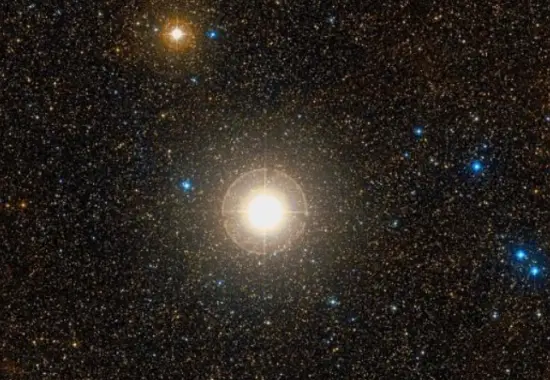
Aljanah (Epsilon Cygni), image: Wikisky
Aljanah has the spectrum of an orange giant of the spectral type K0 III. It has a mass about twice that of the Sun and a radius 10.82 times solar. It shines with 62 solar luminosities with an effective temperature of 4,710 K. The star is a slow spinner. With a projected rotational velocity of about 2.3 km/s, it takes 0.67 years to complete a rotation. The star’s estimated age is about 1.5 billion years.
Aljanah spent its main sequence lifetime as a class A dwarf and evolved into a class K red giant star only tens of millions of years ago. Even though it is much younger than the Sun, it is already in the final stages of its life because it is more massive, and it burned through its supply of fuel faster.
Facts
Aljanah is one of the five bright Cygnus stars that form the Northern Cross. The Northern Cross is one of the most prominent star patterns in the northern celestial hemisphere. It outlines the body of the Swan. The asterism is formed by Deneb (Alpha Cygni), Sadr (Gamma Cygni), Albireo (Beta Cygni), Aljanah (Epsilon Cygni), and Fawaris (Delta Cygni). Most of it lies within the Summer Triangle, a larger asterism formed by Deneb with Vega in the constellation Lyra and Altair in Aquila.
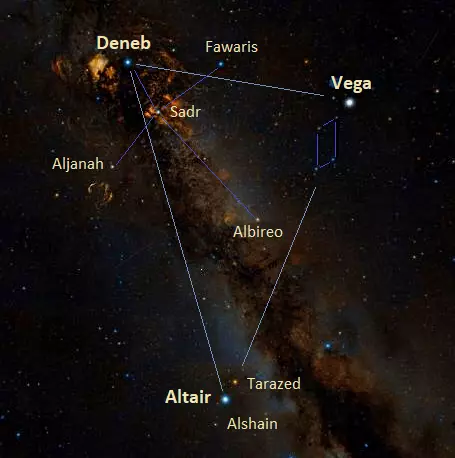
The Northern Cross and the Summer Triangle, image: Wikisky
Aljanah has been a spectral standard for the Morgan-Keenan system of spectral classification since 1943. The star’s spectrum serves as one of the anchor points used to classify other stars.
Name
The name Aljanah (pronunciation: /ˈældʒənə/) is derived from the Arabic al janāħ, meaning “the wing.” It refers to the star’s position in the constellation Cygnus, marking the wing of the Swan. The name was approved by the International Astronomical Union’s (IAU) Working Group on Star Names (WGSN) on June 30, 2017. It formally applies only to the component Epsilon Cygni Aa.
Epsilon Cygni was traditionally also known as Gienah. The name has the same etymology as Aljanah. The star shared both names (Gienah and Aljanah) with the blue giant Gamma Corvi, the brightest star in the constellation Corvus. Gamma Corvi marks the wing of the celestial Crow and is now formally known as Gienah. Historically, the stars were often called Gienah Cygni and Gienah Corvi to avoid confusion.
In Chinese astronomy, Epsilon Cygni was known as the Ninth Star of Celestial Ford (天津九). It was part of an asterism called Celestial Ford along with Sadr (Gamma Cygni), Fawaris (Delta Cygni), 30 Cygni, Deneb (Alpha Cygni), Nu Cygni, Tau Cygni, Upsilon Cygni, and Zeta Cygni. The asterism was part of the Girl mansion, one of the northern mansions of the Black Tortoise.
Location
Aljanah is easy to find because it is quite bright and part of a recognizable northern summer asterism, the Northern Cross. It forms the crossbeam with Sadr and Fawaris. The Northern Cross lies in a rich Milky Way field and can be used to find many bright deep sky objects in this region of the sky.
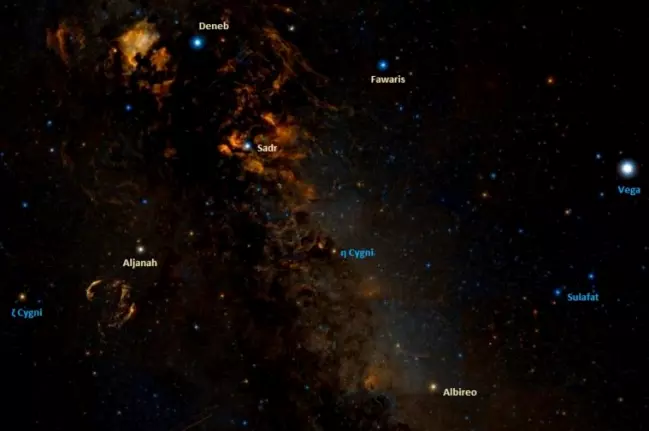
The Northern Cross, image: Wikisky
Aljanah appears only 3 degrees north of the Veil Nebula, a vast nebula and probable supernova remnant located at an approximate distance of 2,400 light-years. The nebula forms the visible part of the Cygnus Loop, the remnant of a supernova that occurred between 10,000 and 20,000 years ago and was bright enough to be visible in the daytime. The remnant has since expanded to a size of about 3 degrees, or six times the diameter of the full Moon. It has an apparent magnitude of 7.0. It is one of the most popular astrophotography targets in the northern night sky.
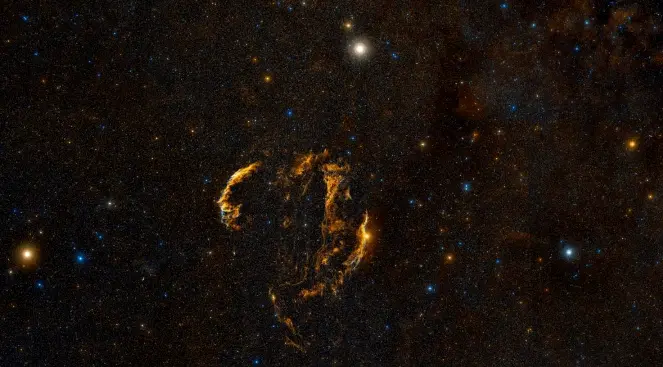
Aljanah (Epsilon Cygni) and the Veil Nebula, image: Wikisky
Constellation
Aljanah is located in the constellation Cygnus. Representing the celestial Swan, Cygnus is one of the 48 ancient constellations, first catalogued by Claudius Ptolemy of Alexandria in his Almagest in the 2nd century CE. It is the 16th largest constellation in the sky, stretching across 804 square degrees.
Cygnus is easily recognizable for the Northern Cross, an asterism formed by the supergiant Deneb, the constellation’s brightest star, with four other evolved stars: the supergiant Sadr, giants Aljanah and Fawaris, and bright giant Albireo.
Other notable stars in the constellation include the dwarf nova SS Cygni, the red hypergiant NML Cygni, the luminous blue variable P Cygni, the high proper motion star 61 Cygni (Bessel’s Star), and Tabby’s Star, a class F main sequence star that earned the nickname WTF Star because of its dramatic irregular changes in brightness. Cygnus is also home to Kepler-22, the first Sun-like star discovered to have a planet orbiting in the habitable zone.
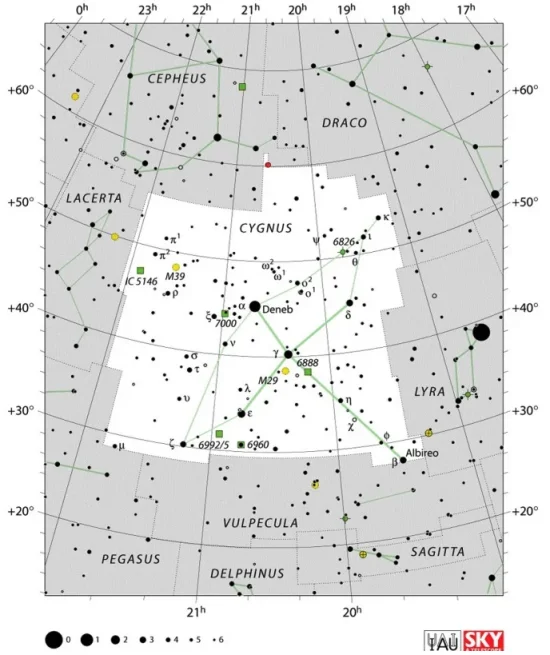
Cygnus constellation map by IAU and Sky&Telescope magazine
Cygnus hosts many well-known deep sky objects. These include the open clusters Messier 29 and Messier 39, the North America Nebula (NGC 7000) and the Pelican Nebula (IC 5070) near Deneb, the Crescent Nebula (NGC 6888) and the Gamma Cygni Nebula (IC 1318) near Sadr, and the Fireworks Galaxy (NGC 6946), a spiral galaxy that hosted ten supernovae in the 20th and early 21st century.
The best time of the year to see the stars and deep sky objects of Cygnus is during the month of September, when the constellation is prominent in the evening sky. Northern observers can catch the constellation high above the horizon from June to December. The entire constellation is visible from all locations between the latitudes 90° N and 40° S.
The 10 brightest stars in Cygnus are Deneb (Alpha Cyg, mag. 1.25), Sadr (Gamma Cyg, mag. 2.23), Aljanah (Epsilon Cyg, mag. 2.48), Fawaris (Delta Cyg, mag. 2.87), Albireo (Beta Cyg, mag. 2.90), Zeta Cygni (mag. 3.21), Xi Cygni (mag. 3.73), Tau Cygni (mag. 3.65 – 3.75), Iota2 Cygni (mag. 3.77), and Kappa Cygni (mag. 3.814).
Aljanah – Epsilon Cygni
| Spectral class | K0 III |
| U-B colour index | +0.860 |
| B-V colour index | +1.030 |
| Apparent magnitude | 2.480 |
| Absolute magnitude | +0.74 ± 0.02 |
| Distance | 72.7 ± 0.2 light-years (22.29 ± 0.06 parsecs) |
| Parallax | 44.86 ± 0.12 mas |
| Radial velocity | -12.599 ± 0.0011 km/s |
| Proper motion | RA: 365.954 ± 1.779 mas/yr |
| Dec.: 308.787 ± 1.769 mas/yr | |
| Mass | ~2 M☉ |
| Luminosity | 62 ± 3 L☉ |
| Radius | 10.82 ± 0.14 R☉ |
| Temperature | 4,710 K |
| Metallicity | –0.27 dex |
| Age | ~1.5 billion years |
| Rotational velocity | 2.3 ± 0.2 km/s |
| Rotation | 0.67 years |
| Surface gravity | 2.8 cgs |
| Constellation | Cygnus |
| Right ascension | 20h 46m 12.6722768426s |
| Declination | +33° 58′ 13.182037125″ |
| Names and designations | Aljanah, Epsilon Cygni, Gienah, ε Cyg, 53 Cygni, HD 197989, HR 7949, HIP 102488, SAO 70474, FK5 780, BD +33°4018, AG+33 2000, Gl 806.1, LHS 5358, GC 28959, GCRV 13020, GCTP 4959.00, LTT 16072, LTT 16073, NLTT 49863, PPM 85489, PLX 4959, IRAS 20442+3347, 2MASS J20461266+3358128, UBV 17995, TYC 2695-4139-1, Gaia DR2 1869302503184405760, ADS 14274 A, IDS 20422+3336 A, WDS 20462+3358 |